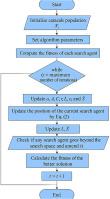基于创新元启发式算法的光伏/电池/风能混合系统多目标优化设计
引用次数: 0
摘要
先进的优化方法对于解决现实世界能源系统的复杂挑战至关重要,特别是那些涉及高维搜索空间的系统。本文介绍了一种新颖的元启发式算法——Caracal Optimization Algorithm (CAO),该算法受到了Caracal狩猎行为的启发,以其精确、敏捷和适应性而闻名。该算法通过模拟野猫的隐身跟踪、爆发性跳跃和动态调整猎物运动,将混沌探索机制和自适应跳跃策略相结合,有效地平衡了全局搜索多样性和局部解优化。这种创新使CAO能够驾驭复杂的解决方案景观,避免局部最优,并实现快速收敛。CAO被用于优化离网混合能源系统的规模,特别是风能/光伏/电池配置,重点关注关键指标,如电力供应损失概率(LPSP)、净当前成本(NPC)和能源平准化成本(LCOE)。该算法与灰狼优化算法(GWO)、鲸鱼优化算法(WOA)、斑马优化算法(ZOA)和粒子群优化算法(PSO)四种已建立的元启发式算法进行了基准测试。对比分析表明,CAO优于这些基准测试,实现了最佳的解决方案质量、更快的收敛速度,并显著减少了计算时间。值得注意的是,CAO将LCOE降至0.1069美元/千瓦时,NPC降至约50,874美元,并且与其他算法相比,具有更快的收敛速度,表现出卓越的能源成本优化。研究结果还强调了光伏发电输出的显著变化,在高太阳辐射期间达到20千瓦的峰值,反映了太阳能的间歇性。风力涡轮机的功率表现出更大的一致性,峰值为12千瓦。电池充放电随天气、时间和季节变化而波动。分析显示,较低的LCOE值出现在有利的金融条件下,例如低通胀和低利率。相反,随着通货膨胀和利率的增加,LCOE值也会增加,这就强调了为了具有成本效益的能源生产,需要尽量减少这些财务因素。这些结果强调了Caracal优化算法在增强混合可再生能源系统方面的潜力,提供了一种更清洁、更具成本效益的解决方案。本研究不仅证明了CAO在优化能源系统方面的有效性,而且突出了其在解决复杂、多目标优化问题方面的适应性,证明了其高效导航高维空间的能力。本文章由计算机程序翻译,如有差异,请以英文原文为准。

Optimal multi-objective design of a Photovoltaic/Battery/Wind hybrid system by implementing an innovative meta-heuristic algorithm
Advancing optimization methodologies is crucial for addressing the complex challenges of real-world energy systems, particularly those involving high-dimensional search spaces. This work introduces the Caracal Optimization Algorithm (CAO), a novel metaheuristic inspired by the hunting behavior of caracals, known for their precision, agility, and adaptability. By mimicking the caracal's stealthy stalking, explosive leaps, and dynamic adjustments to prey movement, the algorithm incorporates chaotic exploration mechanisms and adaptive leap strategies, effectively balancing global search diversity and local solution refinement. This innovation enables the CAO to navigate intricate solution landscapes, avoid local optima, and achieve rapid convergence. The CAO was applied to optimize the sizing of off-grid hybrid energy systems, particularly Wind/Photovoltaic/Battery configurations, focusing on key metrics such as loss of power supply probability (LPSP), net present cost (NPC), and levelized cost of energy (LCOE). The algorithm was benchmarked against four established metaheuristic methods, Grey Wolf Optimization (GWO), Whale Optimization Algorithm (WOA), Zebra Optimization Algorithm (ZOA), and Particle Swarm Optimization (PSO). Comparative analyses showed that CAO outperforms these benchmarks, achieving the best solution quality, faster convergence, and significantly reduced computational time. Notably, CAO reduced the LCOE to 0.1069 US$/kWh, the NPC to approximately US$ 50,874, and demonstrated superior energy cost optimization with faster convergence compared to other algorithms. The findings also highlighted significant variability in photovoltaic power output, peaking at 20 kW during high solar radiation, reflecting the intermittent nature of solar energy. Wind turbine power showed more consistency, peaking at 12 kW. Battery charging and discharging exhibited fluctuations based on weather, time of day, and seasonal changes. The analysis revealed that lower LCOE values occur under favorable financial conditions, such as low inflation and interest rates. Conversely, higher LCOE values were observed with increased inflation and interest rates, emphasizing the need for minimizing these financial factors for cost-effective energy generation. These results underline the Caracal Optimization Algorithm's potential to enhance hybrid renewable energy systems, offering a cleaner, more cost-effective solution. This study not only demonstrates the effectiveness of CAO in optimizing energy systems but also highlights its adaptability in addressing complex, multi-objective optimization problems, proving its capability to navigate high-dimensional spaces efficiently.
求助全文
通过发布文献求助,成功后即可免费获取论文全文。
去求助

 求助内容:
求助内容: 应助结果提醒方式:
应助结果提醒方式:


